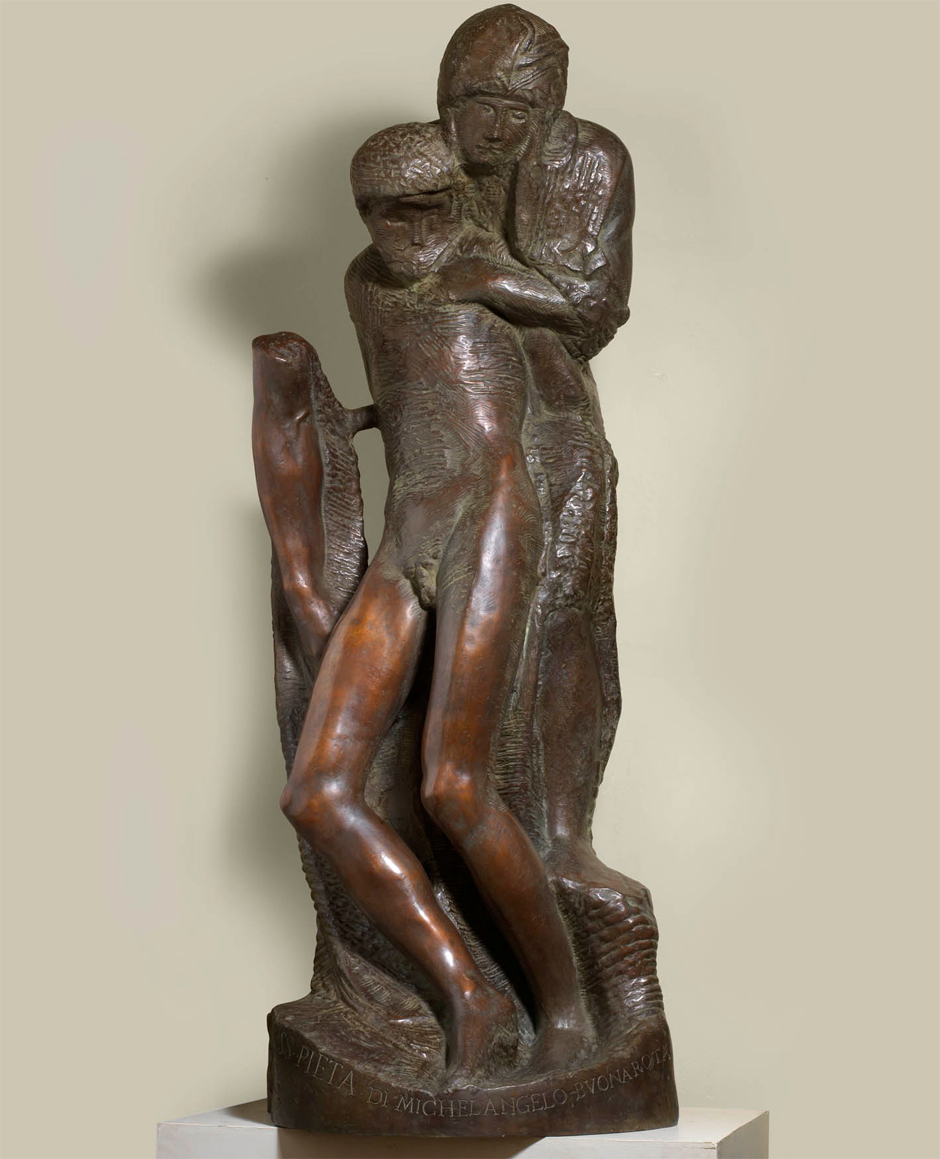The Rondanini Pieta (By Michelangelo ca.1552/53-64; height 74”)
This is the last marble sculpture upon which Michelangelo worked during the last weeks of his life in 1564. It is now in the collection of the Castello Sforzesco in Milan. Daniele da Volterra wrote that Michelangelo had worked on it the whole day on February 12, 1564 — just a week before his death. This sculpture is fascinating for its minimalism, even suggesting the possibility that Michelangelo purposely left it “unfinished,” thereby making it, in some art historian’s view, the earliest piece of “modern art.”
The Pieta Rondanini was ignored for centuries, but Henry Moore, the great twentieth century modernist sculptor, said, “This is the kind of quality you get in the work of old men who are really great. They can simplify; they can leave out . . . in the Rondanini Pieta there’s a whole of Michelangelo’s 89 years’ life somewhere. This Pieta is by someone who knows the whole thing so well he can use a chisel like someone else would use a pen.” [Henry Moore: Writings and Conversations (2002) p.159]
Still, this final Pieta largely conforms to Michelangelo’s first drawings for it: Mary stands elevated on a stone platform and bends over the full length corpse of Christ, supporting it with difficulty, from behind. The two figures have virtually melted into one, with a rigidity that only heightens its emotional appeal that has found admirers in our modern times.
Provenance of The Rondanini Pieta by Michelangelo
Michelangelo di Lodovico Buonarotti Simoni
(Florence 1475 – 1564 Rome)
The Rondanini Pieta
Selected Reference Literature:
Condivi, Vita di Michelangelo Buonarroti…1553; Giorgio Vasari, Lives of the Most Eminent Painters, Sculptors, and Architects, 1550; Charles de Tolnay, Michelangelo: Sculptor, Painter, Architect, 1975; Robert Coughlan, The World of Michelangelo 1475-1564, 1972; Nathaniel Harris, The Art of Michelangelo, 1983; Goldscheider, Ludwig, Michelangelo: Paintings, Sculptures, and Architecture, 1975.
Michelangelo began the first version of the Rondanini Pieta around 1552-1553 and the second in 1555, after the mutilation of the Pieta. The third version dates from shortly before his death in 1564. Michelangelo probably began this group of figures shortly after abandoning his Florentine Pieta, and then seven years later came back to make revisions on his Rondanini Pieta.
Michelangelo is said to have sculpted the Rondanini Pieta as a legacy to his servant Antonio del Franzese. The sculpture was brought to the Palazzo Rondanini, although there is no exact date for when the piece was moved. “In 1952 the sculpture was bought from Conte Sanseverino by the city of Milan for 125 million Lire and placed in the Castle Sforzesco.”
Michelangelo’s first version of the Rondanini Pieta:
“Was probably inspired by a medieval type of Pieta in which the Virgin and Christ are standing. There was also a type of Holy Trinity in the late middle ages in which God the father stands holding the body of Christ, a composition which heralds the Rondanini Pieta.”
“Belonging to the first version, rejected by Michelangelo himself, are the polished legs of Christ, his right hip, and a fragment of his polished right arm which is now detached form the body, and finally a rough-hewn piece of the Virgin’s face turned toward the right, in which one can recognize the forehead, eyes, nose, and veil.” In this Pieta the Christ figure seems to be finished while the Virgin seems to be left in the “rough-hewn” stage. Michelangelo re-worked parts of the sculpture in the last year of his life, including the Virgin’s head which is now facing forward, and the new head of Christ is sculpted from the Virgin’s right shoulder.
In the first version the legs of the Christ and the free right arm are from the first version sculpted by Michelangelo. The elongated rough-hewn figures of Mary and Jesus create an extraordinary impression; it is hard to believe that the work would have gained emotional impact by being finished.
“The tall thin, dematerialized figures of Christ and Mary, carved in part from what was the single body of the Virgin in an earlier version, are literally blended by love into each other.”
There is controversy over whether or not these sculptures can be called finished, but his late style and religious feelings toward death may have been why he left the rough surfaces and vague outline of the figures.
“The elongated rough-hewn figures of Mary and Jesus create an extraordinary impression; it is hard to believe that the work would have gained emotional impact by being finished. On the basis of Michelangelo’s late style and his spiritual conversion, it would seem that the rough surface, glowing softly with light and shadow, fulfilled his purposes in a way that no polished and perfected statues could ever have.”
Late in the completion of the work “the base was partly cut away in front, destroying the toes on Christ’s right foot, and the inscription, ‘SS Pieta di Michelangelo Buonarota’ was carved on it.” On Feb 12, 1564 six days before his death, Michelangelo worked on this Pieta all day as described by Daniele Volterra.
In this sculpture the long sorrowful shapes of Mary and Christ, we can easily see this being a work that would be aesthetically pleasing in the modern era.
On his deathbed, Michelangelo said:
“I regret that I have not done enough for the salvation of my soul and that I am dying just as I am beginning to learn the alphabet of my profession.”
In Michelangelo’s last days his desire for oneness with God is the inspiration the Rondanini Pieta and what drives him to create a Pieta more meaningful and magnificent that his earlier Pieta which rests in St. Peter’s Basilica today.
“In the Rondanini Pieta Michelangelo came even closer to a fusion of his spirit with that of the divine.”
When Michelangelo died in 1564, the Rondanini Pieta was one of the few items mentioned in the inventory of his possessions.

